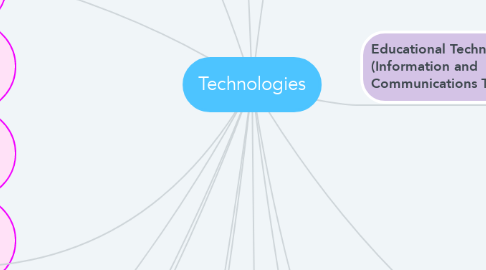
1. Positive
1.1. Improves engagement, improves knowledge retention, encourages individual learning, encourages collaboration
2. Negative
2.1. Transforms learners into inefficient learners, misguided by the wrong information,major sources of distractions, creating enough room for cheating, increase rate of cyberbullying
3. Future
3.1. Helping teachers to expand beyond linear, text-based learning, engage students who learn best in other ways
4. TPACK
4.1. Technological, Pedagogical, And, Content, Knowledge
4.1.1. Work together to increase student motivation and to make the content more accessible to students
4.2. You redesign technology on a daily basis
5. IMPACT
5.1. Pedagogical Framework
5.1.1. Inspire - emotional connection to topic to motivate students
5.1.2. Model - brain searches for visual information e.g. graphics organisers, symbols
5.1.3. Practice - repeat, gradual release of responsibility, feedback, memory
5.1.4. Apply- Problem solving, higher order thinking, meta-cognition
5.1.5. Connect- global connection, personalised connection, collaboration
5.1.6. Transform - transform learners, create and design, 21st century technology, making decisions
6. Technology for inclusive education
6.1. Special provisions
6.1.1. Application of relevant syllabus criteria and standards against which achievement is judges
6.1.2. Assessment criteria standards are not modified to suit particular students
6.1.3. School is required to maintain the intent and rigour of the syllabus
6.1.4. does not involve compensating for what the student does not know or cannot do
6.2. Access Arrangement and Reasonable Adjustments
6.2.1. Signing instead of speaking
6.2.2. computer simulation instead of lab work
6.2.3. specialised equipment (e.g. iBook on the iPad instead of handwriting)
6.2.3.1. Gross -motor skills
6.2.4. digital reader to communicate a text
6.2.5. additional time
6.3. General ideas of assertive technology
6.3.1. Access
6.3.2. Supportive
6.3.3. Curriculum
6.3.4. Framework
6.4. Access hardware for curriculum engagement
6.4.1. Alternative keyboards
6.4.2. mouse alternatives
6.4.3. switch systems
6.4.4. interactive systems
7. Content Specific Technologies
7.1. Computer programs/ games or tutors that present information incrementally with questions to be answered by the learner
7.2. Correct answers are rewarded and incorrect answers are remediated
7.3. Perpetuate miss-conceptions
7.4. Guessing
7.5. underpinned by behavioumist-cognivist views of learner
7.6. mathletics, reading eggs
8. Content Free Technologies
8.1. software or environments that are blank/empty and can be applied to any content/subject domain
8.2. students have to do something in this space
8.3. Constructivist- constructionist view of learning
9. Assistive Technologies
9.1. Are for all learners in the classroom
9.2. You are responsible for your professional learning...technology can help open up a world of opportunity
10. Pedagogy
10.1. Teacher Centred
10.2. Student Centred
10.3. Self-regulates learning
10.4. Not just about content, whole focus of you as a teacher
10.5. PCK- Schulman's content knowledge
10.5.1. Technological Content Knowledge (TCK)
10.5.1.1. Technological Pedagogy Knowledge (TPK
10.6. How do I deliver this for students to understand?
10.6.1. Digital Game? Build a model? Ask a expert?
11. Educational Technologies = ICT (Information and Communications Technologies)
11.1. ICT pedagogies
11.1.1. Behaviourist - Cognitivist
11.1.1.1. knowledge exists external to the child and could be transmitted and received
11.1.1.1.1. software: tutorial programs
11.1.1.1.2. Digital games - supplements enrich, transfer
11.1.2. Constructivist- Constructionist
11.1.2.1. children construct reality for their perceptions
11.1.2.1.1. software that mediates learning
11.1.2.2. Construct their own knowledge
11.1.2.3. big questions, investigations
11.1.3. "Teacher beliefs and technology integration practices: A critical relationship"
11.1.3.1. Teacher centres: drills practice
11.1.3.1.1. Content development
11.1.3.2. Student centred: communication, collaboration
11.1.3.3. Ertmer's reading
11.1.3.3.1. Supplement, Enrich or transform?
11.1.4. Belief - learning theory- pedagogy - ICT
11.2. Digital pedaogies
11.3. 21st century teaching
11.3.1. Gonski's direction
11.3.1.1. Equip every child to be a creative, connected and engaged learner in a rapidly changing world
11.4. The Australian Curriculum: Information and Communications Technologies
11.4.1. ICT Capability
11.4.1.1. Investigating with ICT, Communication with ICT, Creating with ICT
11.4.2. key ideas
11.4.2.1. pedagogy matter
11.4.2.2. children hands
11.4.2.3. enhance learning
11.4.2.4. mindtool not just product
11.4.2.5. right iCT for the task
12. Metacognition
12.1. thinking and thinking and learning processes
12.1.1. Key skills: planning, self-reflecting, self-regulation, motivation, perseverance, evaluation
12.2. self-regulated learning
12.2.1. Pear learning
12.2.1.1. peers learn from and teach each other in formal, and informal settings
12.2.1.2. Students benefit from problem solving and explaining information
13. APST
13.1. 2.6 Implement teaching strategies for using ICT to expand curriculum learning opportunities for students
13.2. 6.2 Understand relevant and appropriate sources of professional learning for teachers
13.3. 7.4 Understand the role of external professionals and community representatives in broadening teachers' professional knowledge and practice
14. Coding
14.1. A literacy - behind every digital device you have coding
14.2. applies knowledge on mathematics
14.3. SCRATCH - popular in schools
14.4. Why code?
14.4.1. write an algorithm
14.4.2. interpret when the code is incorrect
15. Teacher is not the front, students can self organise
15.1. self organising learning system
15.2. we don't need to teach technology, kids can figure it out on their own
15.3. THE CONVERSATION AND SOCIAL INTERACTIONS ARE IMPORTANT
15.3.1. SOCIAL- can form unlikely relationships
15.3.1.1. peers are able to work together and problem solve

